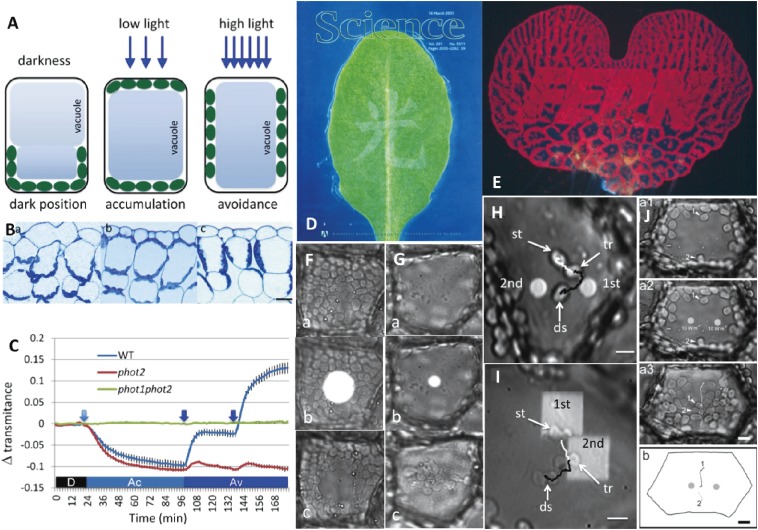Figure 1.
Induction, detection, and analyses of chloroplast photorelocation movement. A. Schematic drawings of chloroplast positions in darkness, and during the accumulation response under weak (low) light and avoidance response under strong (high) light in seed plant palisade cells. In darkness, chloroplasts are present at the bottom of the cells. Under weak light, they occur below the cell surface (periclinal wall) and at the bottom of the cells. Under strong light, the chloroplasts migrate to the sidewall (anticlinal wall). B. Photographs of the adaxial side of Arabidopsis thaliana leaf sections. (a) Dark position. (b) Accumulation response. (c) Avoidance response. Bar: 20 µm. C. Detection of chloroplast movement by red light transmittance through a wild-type (WT) A. thaliana leaf, and phot2 mutant and phot1phot2 double mutant leaves. The WT plant exhibited reduced transmittance under weak light because of the accumulation response (Ac), increased transmittance under strong light because of the avoidance response (Av), and an even greater increase in transmittance with stronger light provided at the time point indicated by an arrow. A phot2 mutant leaf exhibited normal chloroplast accumulation, but almost no avoidance response under strong light. There were no transmittance changes in a double mutant leaf. D. Avoidance response induced in an A. thaliana leaf by the partial irradiation with a strong light beam spelling “light” in Chinese [cover of Science, 16 March 2001 issue (courtesy of Science)]. The discovery of phot2 as the photoreceptor involved in the avoidance response was reported in this journal issue. E. Avoidance response in an Adiantum capillus-veneris gametophyte (prothallus) induced by strong light irradiation outside of the letters (FERN). F. Avoidance response in an A. capillus-veneris prothallial cell continuously irradiated with a blue microbeam (27 µm diameter) before (a), during (b), and after (c) irradiation. G. Accumulation response in a dark-adapted cell irradiated with a red microbeam (8 µm diameter) for 1 min. Other details are the same as in F. H. Accumulation response induced by sequential irradiation of red microbeams (1st and 2nd) for 1 min each in a dark-adapted A. capillus-veneris cell. A chloroplast (st) moved toward the first beam. When the chloroplast reached (tr), a second beam was provided. The chloroplast changed direction and migrated toward the second beam. The movements toward the first beam and to the destination (ds) after the second beam are indicated by white and black lines, respectively. Bar: 10 µm. I. Avoidance response induced by partial chloroplast irradiation with a continuous blue microbeam. Half of a chloroplast (st) was irradiated with a square beam (1st), and the second beam was provided when the chloroplast reached (tr). Other details are the same as in H. Bar: 5 µm. J. Two red microbeams (4 µm diameter) were simultaneously provided for 1 min. Chloroplasts at the same distance from the beams at the cell periphery moved toward the middle of the area between the two beams, but not to either beam. (b) Chloroplast movement path. Bar: 10 µm. Figures A, B, C, H, and I are reproduced from Wada 2013,16) D is from Science (16 March 2001 issue), F, G are from Wada 2013,51) J is from Tsuboi and Wada 2013,74) with copyright permission from Elsevier, Science/AAAS, British Pteridological Society, and Botanical Society of Japan, respectively.

